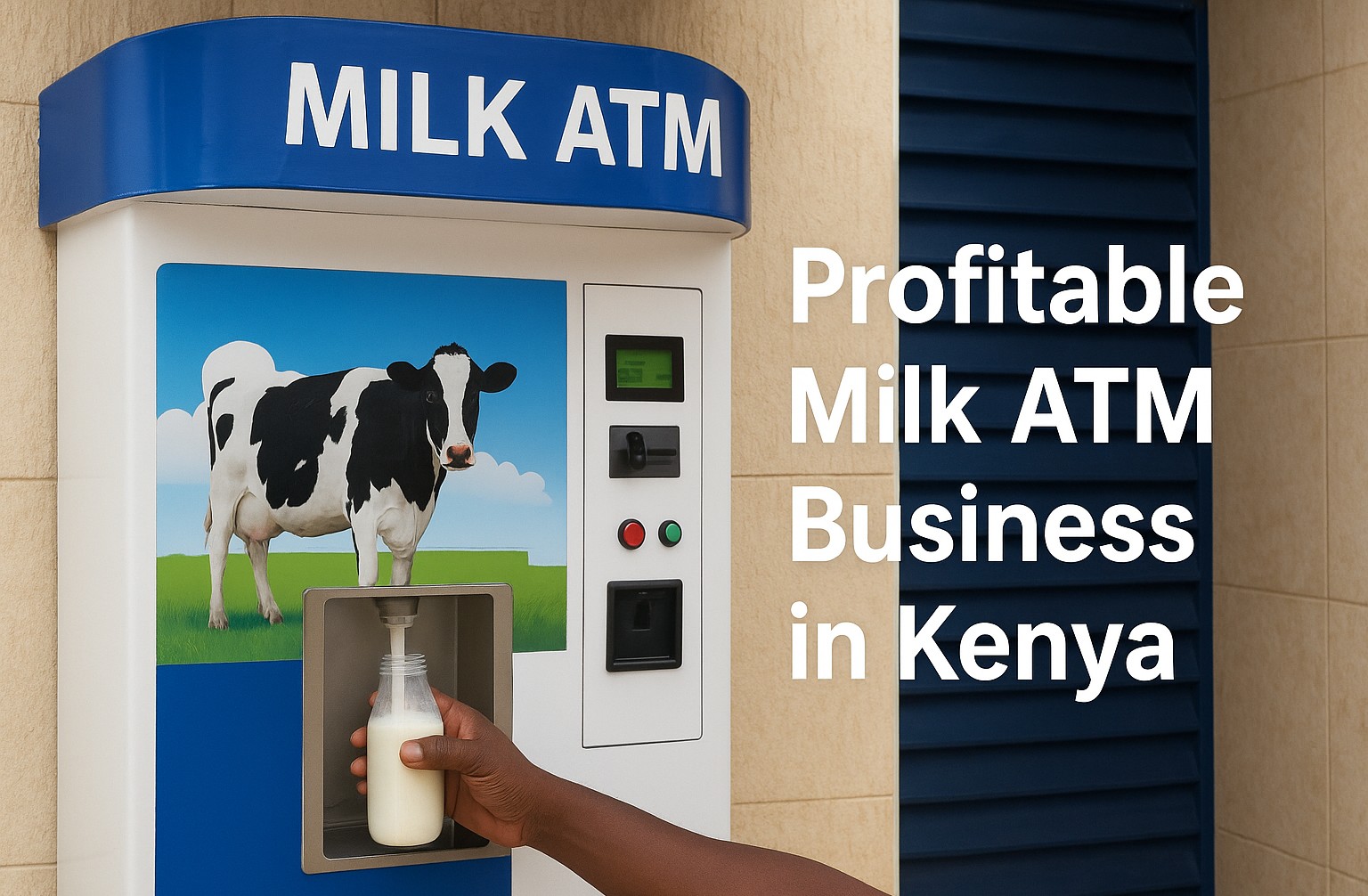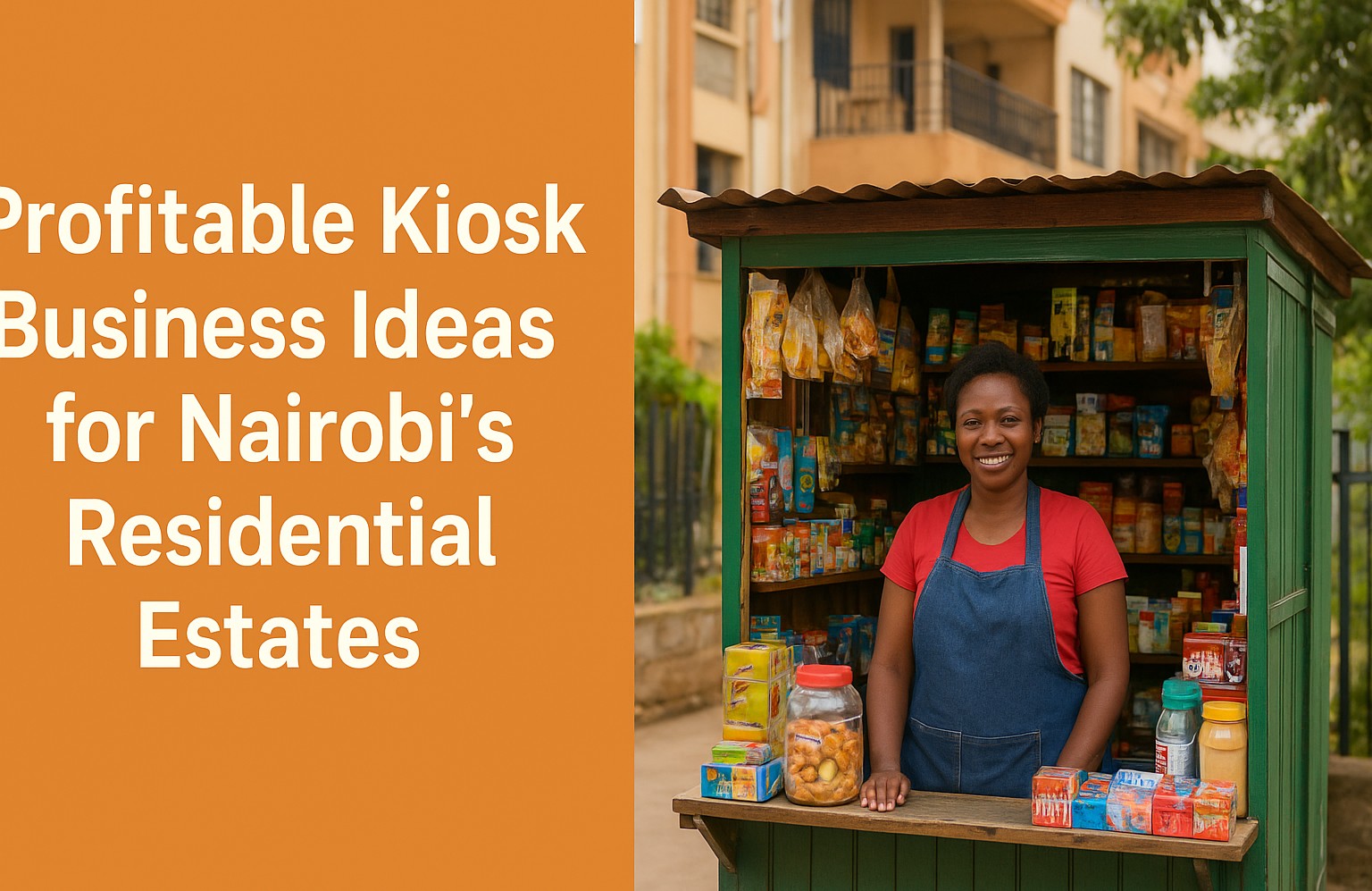

Titus Morebu
Author
Profitable Milk ATM Business in Kenya: A Complete 2025 Guide 🥛
Discover how to launch and scale a milk ATM business in Kenya in 2025 — startup costs, revenue models, compliance, growth tips, and real success stories.
Why the Milk ATM Business in Kenya Holds Immense Potential 🐄
The milk ATM (automated milk dispenser) model has rapidly emerged as one of Kenya’s most disruptive dairy retail innovations over the past decade. With rising urbanization, demand for fresh pasteurized milk, and gaps in cold-chain distribution, milk ATMs offer a cost-efficient, low-waste, consumer-friendly alternative to packaged milk. Reports show growth from just a few units to over a thousand across the country.
Some milk ATM entrepreneurs now report monthly profits exceeding KSh 200,000 in prime locations—showing that with the right planning, this business can be very profitable.
How the Milk ATM Business Works: Core Principles
At its heart, a milk ATM is a vending machine that dispenses pasteurized milk per liter or fractional quantities when customers pay (cash or mobile money). Key advantages:
- No packaging waste: Customers bring their own containers or buy reusable bottles.
- 24/7 access: Machines can operate round the clock in secure, high footfall zones.
- Lower distribution costs: By eliminating middlemen, margins improve.
- Traceability & hygiene: Machines can record transactions, enforce cleaning cycles, and maintain temperature control.
Step 1: Market Research & Location Strategy
The right location can make or break your business. Follow these guidelines:
- High foot traffic areas: Residential estates, near supermarkets, bus stops, hospitals, schools, and commercial hubs.
- Competitive gap analysis: Check if existing milk ATMs nearby are performing poorly (poor quality, stockouts, hygiene issues) — you might capture their customers.
- Pricing sensitivity: Many consumers switching to ATMs do so because it’s cheaper per liter than packaged brands.
- Ease of access & security: The machine must be in safe, well-lit areas to operate 24/7 without vandalism risk.
Step 2: Capital & Startup Costs Breakdown
To launch a milk ATM business, here are the major cost centers you must account for:
| Item | Typical Cost (KSh) | Notes |
|---|---|---|
| Milk ATM machine | 70,000 – 300,000+ | Depends on capacity, features (auto-cleaning, monitoring). Some local units start ~ 70,000. |
| Licensing & registration | 5,000 – 20,000 | County permits, Kenya Dairy Board (KDB) licenses, health certificates. |
| Premises / rent / renovation | 10,000 – 30,000+ | Depends on location; upgrading plumbing, electricity, security. |
| Initial milk supply & pasteurization | 20,000 – 100,000 | Buffer stock to fill machine for the first weeks. |
| Marketing & signage | 5,000 – 15,000 | Awareness, branding, launch promotions. |
| Buffer for utilities, repairs | 5,000 – 15,000 | Electricity, maintenance, minor breakdowns. |
In total, many investors start with KSh 150,000 to 300,000 as working capital — though leaner setups with local fabrication may begin under KSh 100,000 in small-scale pilot phases.
Step 3: Regulatory Compliance & Licensing
You cannot skip this — compliance is key to sustainable operations and consumer trust:
- Kenya Dairy Board (KDB): You must get a milk dispenser license or permit to legally sell milk via ATM.
- Food hygiene / public health licenses: Your milk premises must be inspected, and staff should have food handling certificates.
- County business permit / trade license: As per the county you operate in.
- Standards for equipment: Use food-grade stainless steel, maintain temperature control, auto-cleaning cycles.
- Daily cleaning & record keeping: Many milk ATM operations mandate cleaning at least once a day and keeping dispensing logs.
Step 4: Securing Milk Supply & Pasteurization
Reliable supply is your lifeline. Key strategies:
- Partner with accredited farmers or dairy cooperatives: Negotiate supply contracts, preferably with clause on quality standards and delivery schedules.
- Onsite pasteurization: If no reliable pasteurized supply, invest in small-scale pasteurizers to handle raw milk from farmers.
- Quality control: Test regularly for adulteration, bacterial counts, antibiotic residues, ensure cold chain in transit.
- Buffer stock: Maintain a buffer to prevent stockouts during supply delays.
Step 5: Machine Procurement & Installation
The choice of machine influences uptime, maintenance costs, and user trust:
- Choose machines with auto-clean (CIP) systems to reduce manual cleaning errors.
- Remote monitoring for temperature, milk level, fault alerts is ideal.
- Opt for modular machines so maintenance is easier and spare parts available locally.
- Ensure proper installation: power backup (solar or battery), secure casing, robust plumbing.
Revenue Model & Profit Margins
Here’s how to estimate your revenue and profits:
- Set a realistic price per liter: Many ATMs in Kenya retail milk between KSh 50–60 per liter depending on location and competition.
- Margin per liter: If your cost (including purchase, pasteurization, transport) is KSh 40, your gross margin is KSh 10–20 per liter.
- Daily sales volume: A well-placed ATM could sell 100 – 300 liters per day or more in busy zones.
- Monthly revenue & profit: For example, selling 200 L/day at KSh 55 = KSh 11,000/day revenue. If your margin is KSh 12/L, daily profit = KSh 2,400, or ~KSh 72,000/month (before operating expenses). After factoring rent, utilities, maintenance, your net could range 40-60% of gross sales.
Some operators report net profits of KSh 100,000+ per machine monthly in premium areas. Others report more modest returns in lower density zones.
Risks, Challenges & Mitigation
No business is without risks — here are common ones and how to manage them:
- Quality concerns: If consumers perceive the milk as unsafe or adulterated, they'll avoid your ATM. Mitigation: stringent quality control, certifications, transparency, branding.
- Machine breakdowns: Downtime kills revenue. Mitigation: preventive maintenance, contracts with service providers, spare parts on hand.
- Supply chain disruptions: Droughts, transport issues, or farmer default. Mitigation: multiple suppliers, buffer stocks, contracts.
- Regulatory noncompliance: Fines, shutdowns. Mitigation: always maintain licenses, health inspections, documentation.
- Theft or vandalism: Especially if machines operate overnight. Mitigation: secure locations, CCTV, tamper-proof builds.
Growth Strategies & Scaling Up
Once one ATM is running well, consider:
- Expand to multiple locations: Use profits to deploy second, third machines in surrounding areas.
- Introduce value-added dairy products: Yogurt, flavored milks, whey drinks — these can increase per-customer spend.
- Subscription / loyalty programs: Encourage repeat business with monthly prepayments or loyalty cards.
- Digital integration: Allow ordering via mobile app to pick up at ATM, or integrate mobile money payments seamlessly.
- Partnerships: With supermarkets, petrol stations, educational institutions — host your ATM in their premises and share revenues.
- Brand & marketing: Emphasize “fresh, traceable, no plastic waste” in your messaging to build trust and edge.
Case Studies & Success Stories
Here are a few real-life examples that illustrate the potential:
- Victor in Nairobi West: Invested ~KSh 350,000 and reportedly earns over KSh 200,000 monthly from his ATM in a well-trafficked zone.
- Some milk ATM networks claim net profits of ~KSh 120,000/month per outlet under favorable conditions (good location, consistent supply, minimal downtime).
- Growth in Kenya: From just 3 milk ATMs in 2005 to over 1,500 by 2018, showing rapid adoption and consumer acceptance.
Tips for SEO & Online Visibility of Your Milk ATM Brand
To dominate Google and AI-driven search, do the following:
- Publish guides, blog posts, and “how to” content (like this one) targeting keywords like “milk ATM Kenya”, “start milk business Kenya”.
- Include external authoritative links (e.g. Kenya Dairy Board site, Wikipedia, university dairy research pages) in your content.
- Get listed in business directories and dairy industry portals.
- Include structured data (schema.org) for “LocalBusiness”, “VendingMachine”, etc., so AI search features your machine locations.
- Encourage customer reviews and photos to build user-generated content and trust.
Conclusion: Is It Worth Starting a Milk ATM Business Now?
If you find a good location, secure a reliable milk supply, and maintain high standards, a milk ATM business in Kenya can be highly profitable with attractive margins and scalability. The barriers to entry—machine cost, regulatory compliance, and logistics—are real but manageable with planning.
In 2025, the demand for fresh, affordable dairy is rising. Combining that with smart digital tools, branding, and disciplined operations, you can build a milk ATM business that not only outperforms competitors but becomes a staple in local communities.
Ready to dip into this “liquid gold” opportunity? Start with one well-planned machine, perfect your operations, and scale from there. The milk will flow — and so will the profits. 🚀
Gallery

Related Articles
3 articles
How to Launch a Successful Butchery Business in Kenya: Step-by-Step Guide 🥩
Learn how to start a butchery business in Kenya—licenses, location, suppliers, costs, marketing, risks—and build a profitable meat shop from scratch.

How to Start a Hardware Shop in Kenya: A Practical, Up-to-Date Guide 🛠️
Thinking of launching a hardware shop in Kenya? Learn how to research, register, stock, market, and manage one profitably using modern tools and strategies.

Profitable Kiosk Business Ideas for Nairobi’s Residential Estates 💡
Discover high-return kiosk ideas suited to Nairobi estates. Learn startup tips, location insights & digital enhancements to build a sustainable, profitable mini-business.